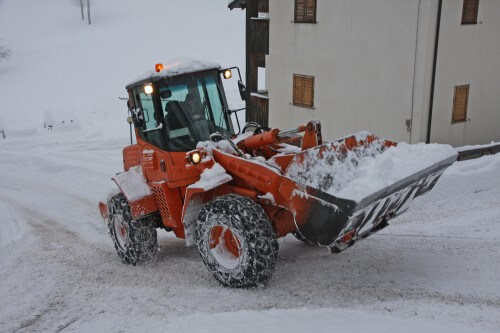The late John Margrave, professor of chemistry at Rice University, provided this answer: In a nutshell: Salt melts ice
From the question and answer section of Scientific American magazine. Published on 22.9.2006
From: Scientific American

Why do we spread salt on ice covered surfaces in winter?
– T. Stadfelt, Huntington Beach, California
The late John Margrave, professor of chemistry at Rice University, provided this answer: In short: Salt melts ice.
All the ice-covered surfaces actually have small puddles of water. Salt spread on such surfaces dissolves. Liquid water has a property called a high dielectric constant, which allows the ions of the sodium chloride salt (positive sodium ions and negative chlorine ions) to separate. These ions, in turn, undergo hydration, that is, bind to water molecules.
This process releases heat that melts microscopic areas of the ice surface. In this way, a large amount of salt spread over a large surface can melt the ice. When cars drive over it, the pressure helps push the salt into the ice and thus more hydration occurs.
Most of the coarse salt that is used in the winter is the same as that in the table salt shaker. The only difference is that the coarse salt has crystallized into larger crystals, and in contrast, the table salt is ground into grains that are more or less uniform in size. Calcium chloride, extracted from seawater and other natural sources, is as common as sodium chloride for de-icing streets.
More of the topic in Hayadan:

9 תגובות
Anonymous handsome
#School
lolly pop
my back
When you apply pressure to ice, the freezing temperature of the ice drops. Therefore, the ice melts where the block exerts pressure, but freezes back when the water is pushed aside.
I saw how a person placed a block on ice and the ice melted and the block did not change what could it be?
Eric, the reaction heat of the first grains dissolves more water into which more salt melts, which creates more heat that dissolves more water, etc. The water that forms as you said is a brine that will not freeze due to the dissolved salt in it. You just need enough salt per liter.
Not clear. It is the lattice energy of sodium chloride that heats the water?... If so then the ice should return to a solid state after the chemical reaction has finished and the "heat" has been released.
According to what I understood, the salt lowers the freezing point of the water molecules around it to minus thirty and this is what causes them to return to a liquid state of aggregation.
I still couldn't figure out what in salt causes the freezing point to be lowered? Isn't the freezing point of table salt (a crystalline or solid state of aggregation) is about eight hundred degrees Celsius... Hence, salt was supposed to raise the freezing point... just like you read with the boiling point of water with the addition of salt (when you cook pasta, add salt to the boiling water to raise the boiling point the boil)
Is there someone who could put things in order???
Thank you!!!
So we wait for rainwater to fill the groundwater reservoirs - then we pour 9 tons of salt into them... nice
So isn't it so that he can stick to the windshield of the vehicles and prevent them from seeing anything while they are trying to get from place to place in a snowstorm? odd.